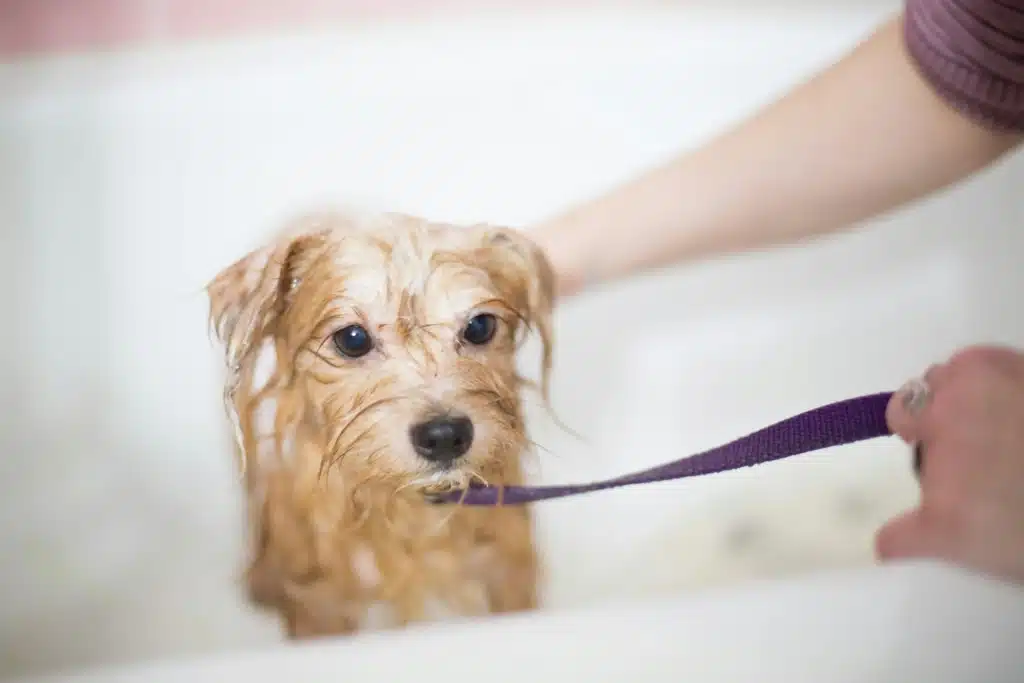How Often Should You Groom Your Dog? Tips from a Professional Groomer
In This Article...
THE OVERVIEW...
Why is Regular Dog Grooming Important?
Welcome to Kuri Dog Grooming – where our dedicated groomers, Shannon and Hannah, help ensure every dog looks and feels their best. Whether you’re a long-time client or new to our services, our approach is designed with your pet’s well-being in mind.
Regular grooming offers numerous health benefits for your dog. It helps distribute natural oils throughout the coat, resulting in a healthy, shiny appearance. Brushing also removes loose hair, preventing matting and reducing shedding around the home. During grooming sessions, you have the opportunity to check for skin issues, lumps, or parasites that might require veterinary attention. For example, Shannon recently identified a minor skin irritation early on during a routine session.
Maintaining a consistent grooming routine not only keeps your dog’s coat and skin in optimal condition but also supports overall hygiene. Regular bathing removes dirt, debris, and odours from the fur, while nail trimming helps prevent discomfort and injury. If you’re interested in learning more about pet health hazards, our discussion on barley grass seeds and their risks may be of interest.
If you would like some advice or wish to bring your dog in for an appointment, do consider giving us a ring on 033555874.
What Are the Health Benefits of Grooming?
Regular grooming offers a host of benefits. Beyond keeping your pet’s coat shiny, it helps to maintain a healthy skin barrier by evenly distributing natural oils. Brushing effectively removes loose hair, minimising matting and reducing excessive shedding indoors.
Grooming sessions are also a practical time to check your dog for skin abnormalities, lumps, or signs of parasites. Early detection of these issues can often lead to prompt treatment, contributing to better overall health.
Additionally, grooming plays a crucial role in your dog’s hygiene. Regular baths remove dirt and odours, while routine nail trims help prevent injuries and discomfort. In our experience at Kuri Dog Grooming, these simple measures have helped many pets avoid more serious issues.
How Does Grooming Affect Your Dog’s Appearance?
Grooming has a significant impact on your dog’s appearance. Regular brushing helps to prevent tangling and matting—especially important for long-haired breeds—while removing dead hair and encouraging a lustrous coat. For dogs that require regular haircuts, such as Poodles or Bichon Frises, professional grooming maintains breed-specific styles and keeps the fur manageable.
Hannah has seen many transformations over the years; often, a little extra care brings out a pet’s natural glow. Treatments like de-shedding and a neat trim not only enhance your dog’s comfort but also contribute to an overall tidy appearance. Many clients appreciate the consistent, refined look that results from a professional grooming session.
What Role Does Grooming Play in Bonding With Your Pet?
Grooming is more than a routine; it’s an opportunity to bond with your furry friend. Spending time brushing, bathing, or trimming your dog’s coat can be both calming and reassuring. Shannon recalls a session in which gentle brushing helped a nervous dog relax completely, thereby laying the foundation for future trust and a positive experience.
Taking a few extra moments to offer praise or a treat during these sessions can create positive associations with grooming. Such personal touches not only make the experience more enjoyable for your pet but also strengthen your bond over time.
Factors Affecting Grooming Frequency
Your dog’s breed, coat type, lifestyle, and age all influence their grooming needs. Different breeds have varying coat textures, lengths, and shedding patterns. For instance, short-haired breeds like Beagles or Boxers generally require less frequent grooming compared to long-haired breeds such as Afghan Hounds. Meanwhile, breeds like Poodles or Bichon Frises often need regular professional grooming to maintain their distinctive style.
At Kuri Dog Grooming, we tailor our approach to suit each pet’s individual needs. Active dogs or those that spend a lot of time outdoors often benefit from more frequent sessions, while puppies may require a gentle introduction to grooming. Senior dogs, with their sensitive skin and potential joint issues, may need softer tools and a more patient approach.
For further details on customised grooming routines, feel free to browse our dog grooming page.
General Grooming Guidelines by Coat Type
How Often Should You Groom Short-Haired Dogs?
Short-haired dogs generally require a simpler routine. Brushing once or twice a week is usually sufficient to remove loose hair and maintain natural oils. Although these breeds don’t need frequent baths, a bath every 2–3 months—or when they become noticeably dirty—is recommended. Regular nail trimming, ear cleaning, and teeth brushing should also form part of the routine, typically every 2–4 weeks.
Even though short-haired dogs have modest grooming needs, regular upkeep is key to maintaining a healthy, vibrant coat and minimising shedding in your home.
What’s the Ideal Grooming Frequency for Medium-Coated Breeds?
Medium-coated breeds often require a more regular routine than short-haired dogs. Brushing 2–3 times a week is usually recommended to prevent matting and remove excess hair. Dogs with thicker undercoats may benefit from extra brushing during shedding seasons. Bathing every 4–6 weeks, along with routine nail and ear care, can help maintain a healthy coat.
Many of our clients with medium-coated dogs have found that a slightly more intensive routine makes a noticeable difference in overall coat condition and appearance.
How Frequently Should Long-Haired Dogs Be Groomed?
Long-haired dogs require the most intensive care to keep their coats free from mats and tangles. Daily brushing is often necessary to remove loose hair, distribute natural oils, and prevent discomfort caused by tangles. For many long-haired breeds, professional grooming every 4–8 weeks is essential to maintain the style and manage the length of the coat. Hannah often recommends daily attention to long coats based on years of experience with these breeds.
Bathing frequency for long-haired dogs generally falls within the 4–6 week range, although some may require more frequent baths to remain clean and odour-free. Alongside regular nail trimming, ear cleaning, and teeth brushing, these measures help maintain both appearance and comfort.
What About Dogs With Special Coat Types (e.g., Wire-Haired, Curly)?
Dogs with special coat types often require unique grooming approaches. Wire-haired breeds, such as many terriers, benefit from regular brushing with a slicker brush to remove dead hair and prevent matting. These breeds might also need occasional hand-stripping—a technique that helps maintain the coat’s texture and character.
Curly-coated breeds, such as Poodles or Bichon Frises, generally require frequent brushing (often daily) to prevent their tight curls from matting. Regular professional grooming every 4–8 weeks is typically needed to keep their distinctive coat looking its best. The specialised care provided by our team helps ensure that every pet’s unique coat is managed appropriately.
Essential Grooming Tasks and Their Frequency
How Often Should You Brush Your Dog’s Coat?
The frequency of brushing depends largely on your dog’s coat type and length. Short-haired dogs might only need brushing 1–2 times a week, whereas medium- and long-haired breeds benefit from more frequent sessions. Regular brushing not only helps remove loose hair but also stimulates blood circulation and maintains healthy skin.
During grooming sessions, you might also spot potential issues such as lumps or parasites. Our experience at Kuri Dog Grooming has shown that combining a nail trim with regular brushing can create a stress-free environment for your pet.
What’s the Recommended Frequency for Bathing?
Bathing frequency varies according to coat type, lifestyle, and individual needs. Most dogs benefit from a bath every 4–8 weeks. Short-haired dogs with healthy skin might only require a bath every 2–3 months, while long-haired or double-coated breeds may need more frequent baths to remain clean and free from odours. Using a shampoo designed specifically for dogs is essential to avoid skin irritation, and thorough rinsing and drying are critical.
If you’re unsure about the best bathing routine for your pet, our team is always happy to share advice based on our extensive experience.
How Often Should You Trim Your Dog’s Nails?
Regular nail trimming is important to prevent discomfort and maintain proper gait. Generally, most dogs benefit from a nail trim every 3–4 weeks. For dogs that spend a lot of time on hard surfaces, natural wear may reduce the frequency required. However, if you notice your dog’s nails clicking on the floor, it is a clear sign that a trim is due. Should you feel uncertain about trimming at home, our professional team is available to help.
What About Ear Cleaning and Teeth Brushing?
Maintaining your dog’s overall health involves regular ear cleaning and teeth brushing. Dogs with floppy ears or those prone to ear infections may need weekly cleaning, while others might only require it once a month. Daily or at least 2–3 times weekly brushing of your dog’s teeth helps prevent tartar build-up, gum disease, and bad breath. Using products designed specifically for dogs ensures safety and effectiveness.
Seasonal Grooming Considerations
How Does Summer Affect Grooming Needs?
Summer introduces its own set of challenges. Many dogs shed their winter coat during the warmer months, making extra brushing necessary to manage loose hair. Increased outdoor activities, such as swimming or playing in the grass, can also mean that an extra bath is beneficial. It is generally best not to shave double-coated breeds since their fur offers natural protection from the sun.
During hotter weather, extra care should be given to your dog’s paw pads, as hot pavement can cause discomfort. For more information on environmental hazards and pet safety, our Barley Grass blog provides useful insights.
What Special Grooming Requirements Arise in Winter?
Winter poses different challenges. Cold weather can lead to dry, itchy skin, making regular brushing essential to distribute natural oils. For long-haired or double-coated breeds, maintaining a full coat is important for insulation; however, care must be taken to keep the coat free of mats that can trap moisture. Additionally, salt and de-icing chemicals on pavements can irritate your dog’s paw pads, so cleaning them after walks is recommended.
How Should You Adjust Grooming During Shedding Seasons?
During the natural shedding periods in spring and autumn, most dogs lose their old coat to make way for new growth. This increased shedding means that daily brushing may be necessary—especially for double-coated breeds such as German Shepherds or Huskies. Tools like undercoat rakes and de-shedding brushes can help remove excess fur without damaging the topcoat. While a de-shedding shampoo during baths can also be beneficial, care should be taken to avoid over-bathing, which may dry out the skin.
Professional vs. At-Home Grooming
When Should You Opt for Professional Grooming Services?
Professional grooming is particularly valuable for pets with high-maintenance coats or when complex tasks (such as de-matting or hand-stripping) are needed. Breeds like Poodles or those with challenging fur often benefit from regular professional appointments, where Shannon and Hannah apply their expertise to achieve the best results. Their careful attention ensures that even the most delicate grooming tasks are handled with care.
That said, many aspects of grooming can be performed safely at home with the right tools and techniques. Regular brushing, bathing with a dog-specific shampoo, and basic nail and ear care are all part of everyday maintenance. If you ever feel uncertain about a particular task, remember that our team is always available to provide advice.
For those moments when you’d appreciate a professional touch, you are welcome to schedule an appointment via our dog grooming page.
What Grooming Tasks Can You Safely Perform at Home?
Many grooming tasks can be managed at home with the right equipment and practice. Brushing, bathing, nail trimming, ear cleaning, and teeth brushing are all tasks that most pet owners can learn with a little guidance. For simpler coats, basic trimming around the face, paws, and sanitary areas is often sufficient. With time, regular home grooming can become a comfortable routine for both you and your pet.
If you’re ever uncertain about your technique or need a refresher on best practices, please feel free to reach out for advice.
How Can You Establish a Balanced Grooming Routine?
A balanced grooming routine involves combining regular at-home care with periodic professional appointments. Begin by assessing your dog’s specific needs based on breed, coat type, lifestyle, and age. Develop a schedule that includes daily or weekly brushing, alongside regular nail trims, ear cleaning, and teeth brushing as recommended by your vet. For more complex grooming, such as full haircuts or de-matting, professional sessions every 4–8 weeks are advisable.
For a personalised grooming plan tailored to your pet, you’re welcome to visit our about us page or contact us directly at 033555874.
Signs Your Dog Needs Grooming
Recognising when your dog requires grooming is essential for their health and comfort. Clear indicators include a visibly dirty or matted coat, tangled fur, and excessive shedding. You might also notice that your dog is scratching more than usual or that their nails are clicking on hard floors—both signs that a grooming session is needed.
Regular grooming not only keeps your pet looking their best but also provides an opportunity to identify any potential health issues at an early stage. Monitoring your dog’s coat and behaviour during these sessions is a key part of responsible pet care.



